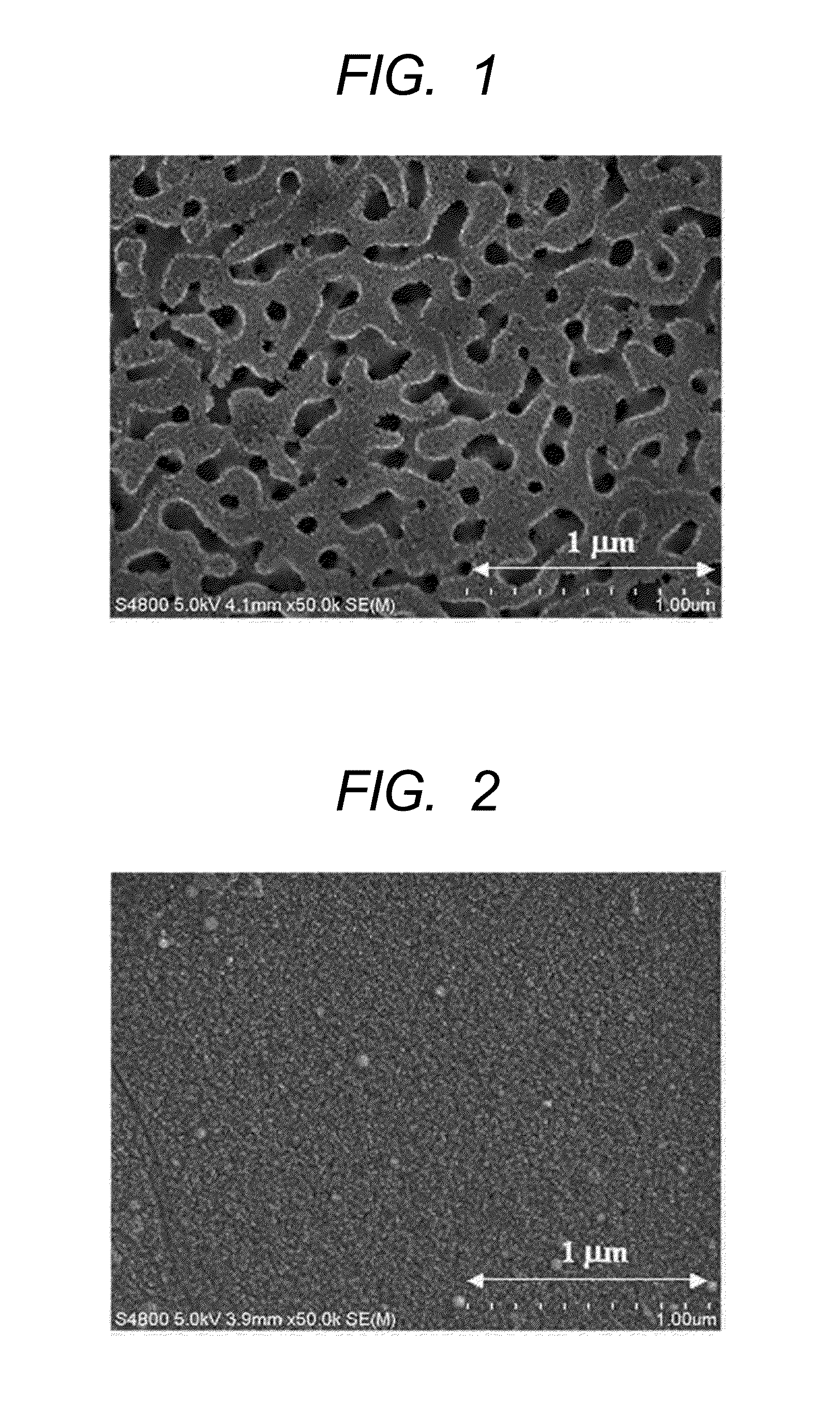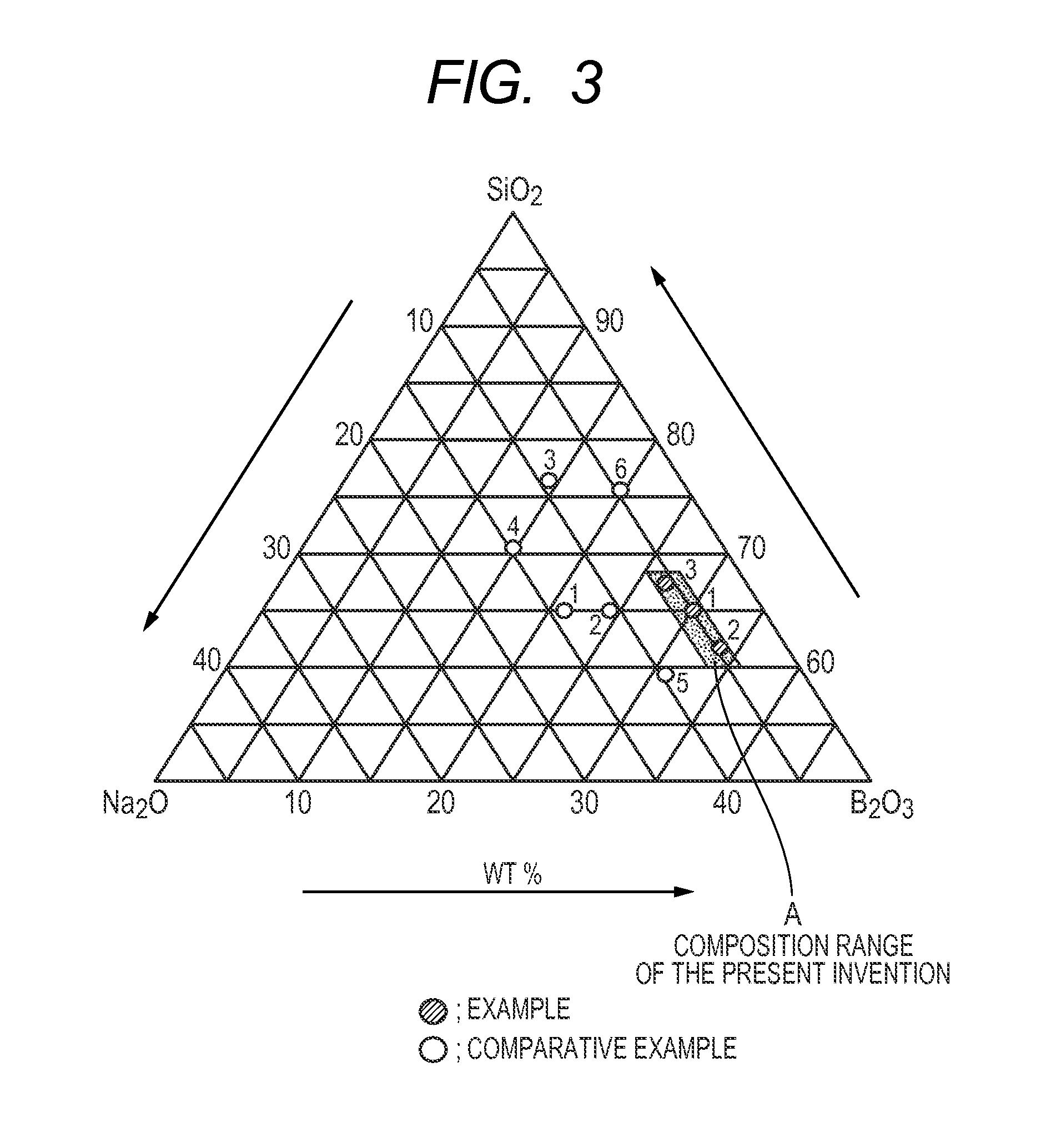Method of producing porous glass
a technology of which is applied in the field of producing porous glass and phase separation glass, to achieve the effect of high strength
- Summary
- Abstract
- Description
- Claims
- Application Information
AI Technical Summary
Benefits of technology
Problems solved by technology
Method used
Image
Examples
example 1
[0043]Sodium carbonate, boric acid, and silicon dioxide were used as glass raw materials. Those raw materials were uniformly mixed at a composition ratio “Na2O:B2O3:SiO2” of 5:30:65 (wt %), and then the mixture was heated at 1350 to 1450° C. so as to melt. After that, the resultant was naturally cooled in a state of being molded into a plate-like shape. Thus, a plate-like glass having a thickness of about 1 mm was obtained.
[0044]A glass body having a composition “5Na2O.30B2O3.65SiO2 (wt %)” obtained by cutting the above-mentioned plate-like glass into a square about one centimeter on a side was immersed in an ion-exchanged water warmed to 80° C. for 3 hours. Thus, a porous glass was obtained. FIG. 1 illustrates the result of the observation of the glass surface of the resultant porous glass with an electron microscope. As can be seen from FIG. 1, a spinodal-type porous structure is formed. In addition, the resultant porous glass showed no cracking in association with water absorptio...
example 2
[0045]Sodium carbonate, boric acid, and silicon dioxide were used as glass raw materials. Those raw materials were uniformly mixed at a composition ratio “Na2O:B2O3:SiO2” of 4.5:34:61.5 (wt %), and then the mixture was heated at 1350 to 1450° C. so as to melt. After that, the resultant was naturally cooled in a state of being molded into a plate-like shape. Thus, a plate-like glass having a thickness of about 1 mm was obtained.
[0046]A glass body having a composition “4.5Na2O.34B2O3.61.5SiO2 (wt %)” obtained by cutting the above-mentioned plate-like glass into a square about one centimeter on a side was immersed in an ion-exchanged water warmed to 80° C. for 3 hours. Thus, a porous glass was obtained. The surface of a glass thus obtained was observed with an electron microscope. As a result, a spinodal-type porous structure was found to be formed as in the case of Example 1. In addition, the resultant porous glass showed no cracking in association with water absorption.
example 3
[0047]Sodium carbonate, boric acid, and silicon dioxide were used as glass raw materials. Those raw materials were uniformly mixed at a composition ratio “Na2O:B2O3:SiO2” of 6:27:67 (wt %), and then the mixture was heated at 1350 to 1450° C. so as to melt. After that, the resultant was naturally cooled in a state of being molded into a plate-like shape. Thus, a plate-like glass having a thickness of about 1 mm was obtained.
[0048]A glass body having a composition “6Na2O.27B2O3.67SiO2 (wt %)” obtained by cutting the above-mentioned plate-like glass into a square about one centimeter on a side was immersed in an ion-exchanged water warmed to 80° C. for 3 hours. Thus, a porous glass was obtained. The surface of a glass thus obtained was observed with an electron microscope. As a result, a spinodal-type porous structure was found to be formed as in the case of Example 1. In addition, the resultant porous glass showed no cracking in association with water absorption.
PUM
| Property | Measurement | Unit |
|---|---|---|
| temperature | aaaaa | aaaaa |
| temperature | aaaaa | aaaaa |
| temperature | aaaaa | aaaaa |
Abstract
Description
Claims
Application Information
 Login to View More
Login to View More - R&D
- Intellectual Property
- Life Sciences
- Materials
- Tech Scout
- Unparalleled Data Quality
- Higher Quality Content
- 60% Fewer Hallucinations
Browse by: Latest US Patents, China's latest patents, Technical Efficacy Thesaurus, Application Domain, Technology Topic, Popular Technical Reports.
© 2025 PatSnap. All rights reserved.Legal|Privacy policy|Modern Slavery Act Transparency Statement|Sitemap|About US| Contact US: help@patsnap.com



